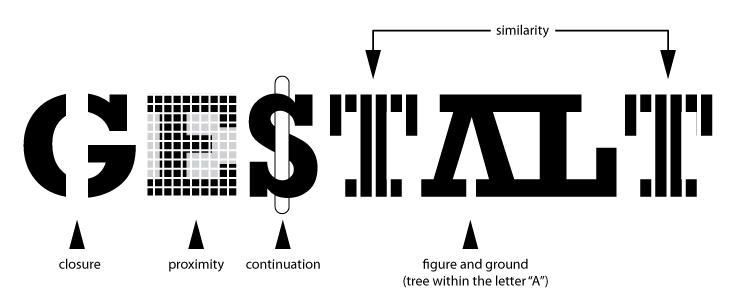- 17,133
- Posts
- 12
- Years
- she / they
- Seen Jan 12, 2024

"Gestalt is a psychology term which means "unified whole". It refers to theories of visual perception developed by German psychologists in the 1920s. These theories attempt to describe how people tend to organize visual elements into groups or unified wholes when certain principles are applied."
The Five Principles of Gestalt Psychology
I. Closure
Closure occurs when an object is incomplete or a space is not completely enclosed. If enough of the shape is indicated, people perceive the whole by filling in the missing information. Although the panda below is not complete, enough is present for the eye to complete the shape. When the viewer's perception completes a shape, closure occurs.


II. Continuation
Continuation occurs when the eye is compelled to move through one object and continue to another object, creating an implied visual path. Continuation occurs in the example below, because the viewer's eye will naturally follow a line or a curve. The smooth flowing crossbar of the "H" leads the eye directly to the maple leaf.


III. Figure/Ground
The eye differentiates an object form its surrounding area. a form, silhouette, or shape is naturally perceived as figure (object), while the surrounding area is perceived as ground (background). Balancing figure and ground can make the perceived image more clear. Using unusual figure/ground relationships can add interest and subtlety to an image.
In the image below of the shade, the figure and ground relationships change as the eye perceives the the form of a shade or the silhouette of a face.

The image below uses complex figure/ground relationships which change upon perceiving leaves, water and tree trunk.

In the image below of the shade, the figure and ground relationships change as the eye perceives the the form of a shade or the silhouette of a face.

The image below uses complex figure/ground relationships which change upon perceiving leaves, water and tree trunk.

IV. Proximity
Proximity occurs when elements are placed close together. They tend to be perceived as a group.
The nine squares below are placed without proximity. They are perceived as separate shapes.

When the squares are given close proximity, unity occurs. While they continue to be separate shapes, they are now perceived as one group.

The fifteen figures below form a unified whole (the shape of a tree) because of their proximity.

The nine squares below are placed without proximity. They are perceived as separate shapes.

When the squares are given close proximity, unity occurs. While they continue to be separate shapes, they are now perceived as one group.

The fifteen figures below form a unified whole (the shape of a tree) because of their proximity.

V. Similarity
Similarity occurs when objects look similar to one another. People often perceive them as a group or pattern.
The example below (containing 11 distinct objects) appears as as single unit because all of the shapes have similarity. Unity occurs because the triangular shapes at the bottom of the eagle symbol look similar to the shapes that form the sunburst.

When similarity occurs, an object can be emphasized if it is dissimilar to the others. This is called anomaly. The figure on the far right becomes a focal point because it is dissimilar to the other shapes.

The example below (containing 11 distinct objects) appears as as single unit because all of the shapes have similarity. Unity occurs because the triangular shapes at the bottom of the eagle symbol look similar to the shapes that form the sunburst.

When similarity occurs, an object can be emphasized if it is dissimilar to the others. This is called anomaly. The figure on the far right becomes a focal point because it is dissimilar to the other shapes.

Last edited:
